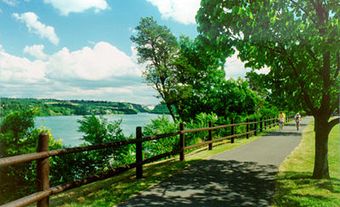The Bruce Trail is a continuous, 740 km footpath on the Niagara Escarpment connecting Queenston, near Niagara Falls, with the village of Tobermory in the Bruce Peninsula, Ontario. The trail follows the escarpment cliff through the fruit lands of Niagara and the city of Hamilton, across the Dundas Valley, north through the Caledon Hills to the Blue Mountains, then northwest across the Beaver Valley to Owen Sound and onward, seldom out of sight of Lake Huron's Georgian Bay, to Tobermory.
History
The idea for a nature trail across Ontario leading to "the Bruce," a paradise for naturalists, was proposed by Raymond Lowes, a Stelco metallurgist, in 1960, and from this idea the Bruce Trail Association (whose volunteer members built the trail) grew into a dedicated organization that manages the trail and channels the efforts of its members into maintenance, appropriate hiking behaviour, nature appreciation and respect for landowners' property. Public-spirited landowners gave permission for the trail route to cross their properties.
Preservation
This opportunity to explore Ontario on foot has been grasped by thousands, making the trail an important tourist attraction for Canada and encouraging the Ontario government to preserve the Niagara escarpment. The escarpment was designated a United Nations Biosphere Reserve in 1990.

 Share on Facebook
Share on Facebook Share on X
Share on X Share by Email
Share by Email Share on Google Classroom
Share on Google Classroom





